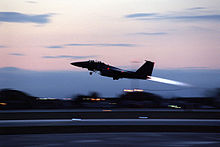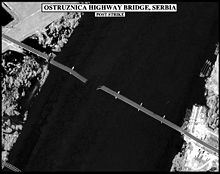NATO bombing of Yugoslavia: Difference between revisions
No edit summary |
No edit summary |
||
| Line 23: | Line 23: | ||
===Military effects=== |
===Military effects=== |
||
Military casualties on the NATO side were remarkably light; according to official reports the alliance suffered no fatalities as a result of combat operations. However, on May 5th, an American military [[AH-64 Apache]] helicopter crashed during a nighttime mission outside [[Tirana]], [[Albania]]<ref name=NATOlosses/>. The Yugoslavs claimed it was shot down since it exploded in the air (no accident can cause explosion in the air) but NATO claimed it crashed due to a technical malfunction. The chopper crashed on Albanian/Kosovo border. The two american pilots of the helicopter Army [[Chief Warrant Officer]]s David Gibbs and Kevin Reichert died in that crash. There were other casualties after the war, mostly due to landmines. After the war, the alliance reported the loss of three helicopters, 32 [[UAV|unmanned air vehicles]] (UAVs) and five aircraft — all of them American, including the first stealth plane (a [[F-117 Nighthawk|F-117]] Fighter Bomber) shot down by enemy fire. The Yugoslav armed forces claimed to have shot down seven helicopters, 30 UAVs, 61 planes and 238 cruise missiles. However, these figures were not verified independently. |
|||
Revision as of 22:28, 22 June 2006
You must add a |reason= parameter to this Cleanup template – replace it with {{Cleanup|reason=<Fill reason here>}}, or remove the Cleanup template.

Operation Allied Force was NATO's military operation against Federal Republic of Yugoslavia that lasted from 24 March to 11 June 1999 and is considered a part of Kosovo War. It was only the second major combat operation in NATO's history, following the September 1995 Operation Deliberate Force in Bosnia and Herzegovina.
Goals
NATO's proclaimed goal was to protect the Kosovo Albanian people from what it regarded as aggression by the military of the Federal Republic of Yugoslavia, Serbian paramilitary police forces and irregular militias allied to the Serbian government. The Yugoslav Government claimed that it was protecting the minority Serbian population of Kosovo against attacks by what it had classified as a Terrorist Organisation: the Kosovo Liberation Army.
Strategy

Operation Allied Force relied almost exclusively on the use of a large-scale air campaign to destroy Yugoslav targets from high altitudes. Ground units were not used, although their use was threatened near the end of the conflict. This approach was adopted to minimise the risk to the NATO forces and attracted considerable public criticism due to its relative ineffectiveness against mobile ground targets such as tanks and troop formations. Strategic targets such as bridges and factories were also bombed, particularly in the later stages of the conflict. Long-range cruise missiles were used to hit a number of heavily defended targets such as strategic installations in Belgrade and Pristina. Civilian installations such as power plants,water processing plants and the state-owned broadcaster were also intentionally targeted. The Chinese Embassy was also hit in the raids and conspiracy theories abound over whether this may have been intentional too. There are indications that the Chinese Embassy housed a radar which was used to spot American planes and so subsequently became a military target.
Forces employed by NATO
Aviation
The main element of the operation was the air forces of NATO, principally drawn from the United States Air Force. The British Royal Air Force operated the Harrier GR7 and Tornado fighter jets as-well as an array of support aircraft. The Canadian Airforce deployed CF-18s which were responsible for 10% of all bombs dropped. The fighters were armed with guided missiles, including the Paveway series, and were also armed with unguided 'dumb' bombs. The war saw the first time that the German Luftwaffe actively participated in combat operations since the end of the Second World War and the American B-2 Spirit stealth bomber also saw its first combat.
Naval
NATO naval forces operated in the Adriatic. The United States Navy provided a substantial naval task force that included the aircraft carrier USS Theodore Roosevelt and the amphibious assault ship USS Kearsarge. The French Navy provided the aircraft carrier FS Foch and a number of escorts. The British Royal Navy sent a substantial task force including the aicraft carrier HMS Invincible, operating Sea Harrier FA2 fighter jets. The RN also deployed a number of destroyers and frigates and the Royal Fleet Auxiliary (RFA) provided support vessels, including the aviation training/primary casualty receiving ship RFA Argus. It was the first time that the RN used cruise missiles in combat, operated from the nuclear fleet submarine HMS Splendid.
Army
US ground forces included a battalion from the 82nd Airborne Division, 505th Parachute Infantry Regiment. The unit was deployed in March 1999 to Albania in support of the bombing campaign where the Battalion secured the Tirana, Albania airfield; secured apache attack helicopter refueling sites; established a forward operating base to prepare for MLRS (Multiple Launch Rocket System) strikes and offensive ground operations; and a small team deployed forward with a Q-36 radar system to the Albania/Kosovo border where they acquisitioned targets for allied/NATO air strikes. Immediately after the bombing campaign the battalion was refitted back at Tirana airfield and issued orders to move into Kosovo as the Initial Entry Force in support of Operation Joint Guardian.
Military effects
Military casualties on the NATO side were remarkably light; according to official reports the alliance suffered no fatalities as a result of combat operations. However, on May 5th, an American military AH-64 Apache helicopter crashed during a nighttime mission outside Tirana, Albania[1]. The Yugoslavs claimed it was shot down since it exploded in the air (no accident can cause explosion in the air) but NATO claimed it crashed due to a technical malfunction. The chopper crashed on Albanian/Kosovo border. The two american pilots of the helicopter Army Chief Warrant Officers David Gibbs and Kevin Reichert died in that crash. There were other casualties after the war, mostly due to landmines. After the war, the alliance reported the loss of three helicopters, 32 unmanned air vehicles (UAVs) and five aircraft — all of them American, including the first stealth plane (a F-117 Fighter Bomber) shot down by enemy fire. The Yugoslav armed forces claimed to have shot down seven helicopters, 30 UAVs, 61 planes and 238 cruise missiles. However, these figures were not verified independently.
Outcome
The war began on 24 March and lasted until 11 June. Following credible threats of a NATO ground invasion and a strong diplomatic initiative from Russia, the Yugoslav government agreed to withdraw its forces from Kosovo and the bombing was suspended on 11 June. On 12 June the US Army's elite 82nd Airborne, 2-505th Parachute Infantry Regiment spearheaded into war-torn Kosovo as part of Operation Joint Guardian.
Operation Allied Force inflicted less damage on the Yugoslav military than originally thought, due to the use of ingenious camouflage and misdirection techniques to disguise military targets. While NATO believed it had destroyed about 200 Serbian tanks during the conflict, only 12 were subsequently confirmed destroyed. It was only in the later stages of the campaign that strategic targets such as bridges and buildings were attacked in any systematic way, causing significant disruption and economic damage. This stage of the campaign led to a number of controversial incidents, such as the bombing of the People's Republic of China embassy in Belgrade, an attack on Serbia's principal TV station and the bombing of chemical factories which resulted in major pollution incidents.
Yugoslav President Slobodan Milošević survived the conflict and declared its outcome a major victory for Yugoslavia and Serbia. He was, however, indicted for war crimes by the International Criminal Tribunal for the Former Yugoslavia along with a number of other senior Serbian and Yugoslav political and military figures. This led to him – and Yugoslavia as a whole – being treated as a pariah by much of the international community, as he was subject to arrest if he left Yugoslavia. The country's economy was badly affected by the conflict and a year later, popular disillusionment with the Milošević regime led to his overthrow.
The campaign failed in its proclaimed objective, in that thousands were killed during the conflict and hundreds of thousands more fled from the province to other parts of the country and to the surrounding countries. Most of the Albanian refugees returned home within a few weeks or months. However, most of the non-Albanian population again fled to other parts of Serbia or to protected enclaves within Kosovo. Albanian guerilla activity spread into other parts of Serbia and to neighbouring Macedonia, but subsided in 2001. The non-Albanian population has since diminished further following fresh outbreaks of intercommunal conflict and harassment, and veterans of the officially disbanded KLA are threatening with renewed violence if their demand for secession is not fulfilled.
A NATO-led peacekeeping force, KFOR, under U.N. wing continues to maintain a precarious peace in Kosovo. Although another large-scale conflict between Serbian and Albanian Kosovans looks unlikely in the near future, the region continues to suffer the effects of poverty, widespread organized crime and ethnic tensions.
In December 2002 HM Queen Elizabeth II approved the awarding of the Battle Honour "Kosovo" to squadrons of the RAF that participated in the conflict. These were: Nos 1, 7, 8, 9, 14, 23, 31, 51, 101, and 216 squadrons. Squadrons that are boldened are authorised to have the battle honour emblazoned on their Colours.
See also
- Headquarters Allied Command Europe Rapid Reaction Corps
- Kosovo war
- Legitimacy of NATO bombing of Yugoslavia
External Links
- "Why Milosevic Decided to Settle the Conflict Over Kosovo When He Did" by the RAND Corporation, 2001[1]
- "Kosovo: The Limits of Air Power II" by Col Anthony L. Hinen, USAF, 2002 [2]
- "Compromised Command," review of Wesley Clarke's book "Waging Modern War: Bosnia, Kosovo, and the Future of Combat" by Betts, Richard K. ,Foreign Affairs, July/August 2001 [3]
- Nato declares the end to war
- US Air Strike on China's Embassy in Belgrade in 1999 was Deliberate Defense & Foreign Affairs Strategic Policy, December 29, 2005
